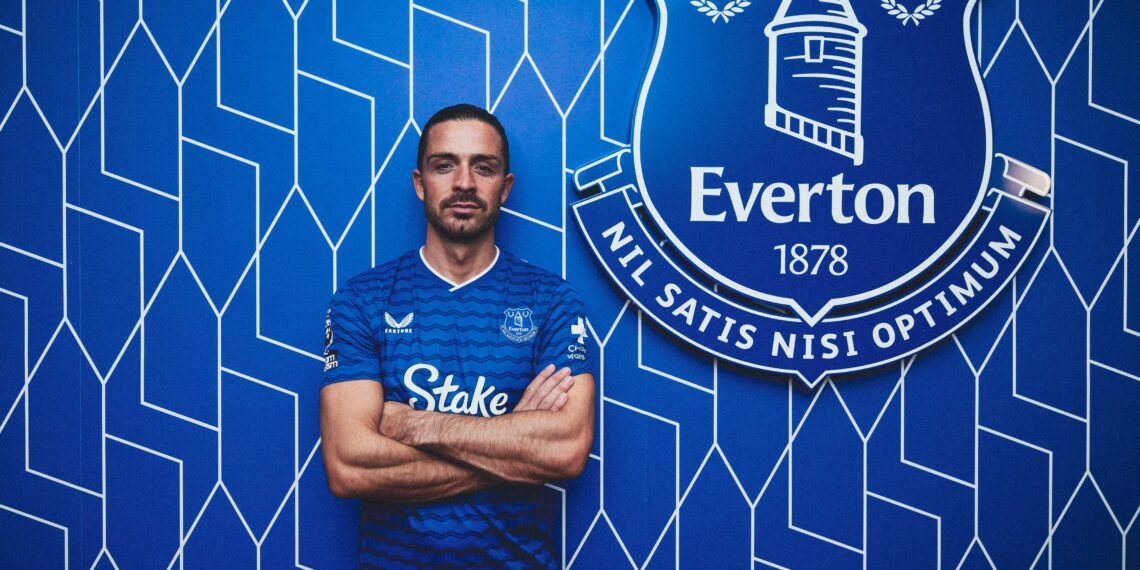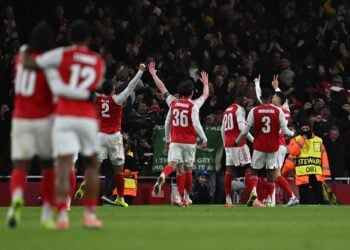As Jack Grealish approaches his 30th birthday next month, this loan move to Everton represents perhaps his final opportunity to revive an ailing career. The winger who was once a key cog in Manchester City’s treble-winning machine now finds himself needing to prove his worth all over again. Given where he stood just two years ago – on top of the footballing world – this feels like an almighty fall from grace.
Table of Contents
The Dramatic Decline: From Treble Hero to Forgotten Man
The contrast in Jack Grealish’s fortunes tells a sobering story of how quickly things can change in elite football. In May 2023, he played 90 minutes in Manchester City’s Champions League final victory over Inter Milan, cementing his place in one of the greatest teams in football history. That same month, he featured for 89 minutes in the FA Cup final against Manchester United, only being withdrawn when Pep Guardiola introduced an extra centre-back to secure a 2-1 victory.
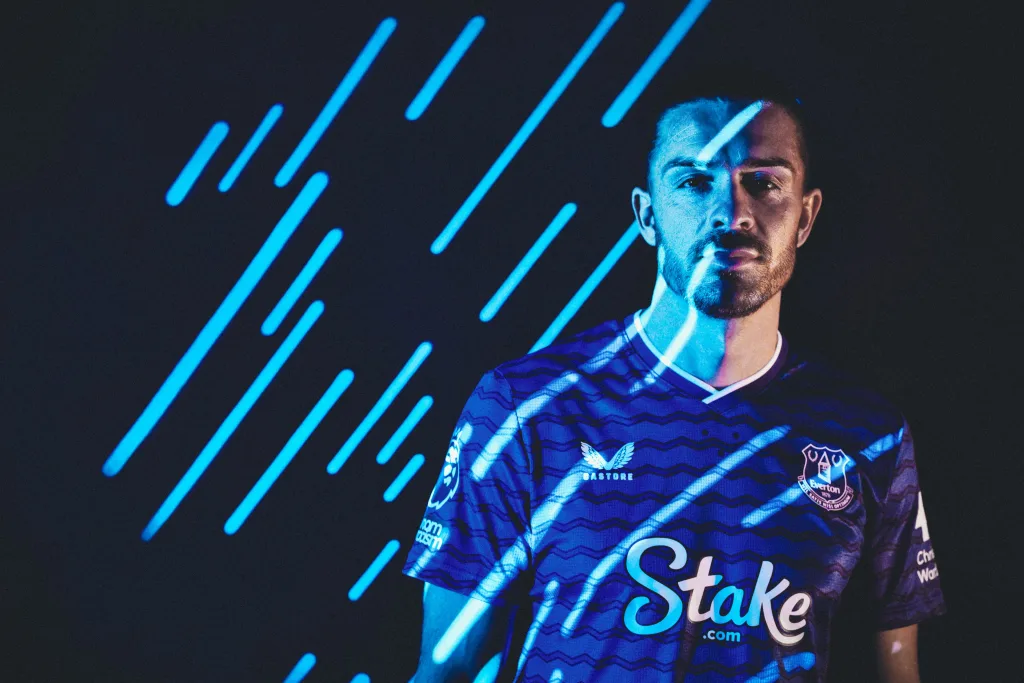
Back then, Grealish was among the players Guardiola valued most. His Premier League minutes were carefully managed to keep him fresh for the biggest occasions, but he consistently started the most important matches and proved vital in many of them. The treble-winning campaign of 2022-23 represented the pinnacle of his career.
However, after a summer of, well, enjoying himself, injuries disrupted the start of the following season, and his Manchester City career never truly recovered. He certainly never returned to his best form in City blue.
The Numbers Behind the Fall
The statistics paint a stark picture of Jack Grealish’s decline. In 2023-24, he managed only 1,004 minutes in the Premier League – less than half the previous season’s total – and looked increasingly ineffective when he did feature. The disappointment was compounded when he was left “heartbroken” after failing to make England’s squad for Euro 2024.
Unfortunately for Grealish, the 2024-25 season proved even less fruitful. Despite Manchester City struggling on multiple fronts, he could barely secure a place in the starting eleven. The numbers are damning: despite being available for selection 82% of the time, Jack Grealish played just 30% of City’s available minutes.
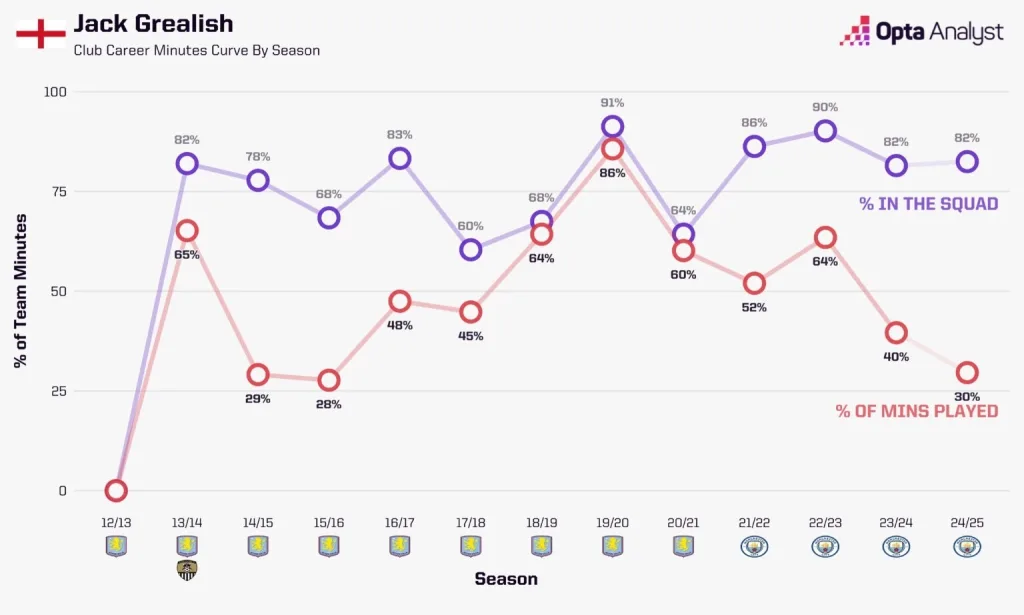
| Season | Premier League Minutes | Goals | Key Moments |
|---|---|---|---|
| 2022-23 | 2,000+ | Multiple | Champions League final, FA Cup final |
| 2023-24 | 1,004 | Limited | Dropped from England Euro 2024 squad |
| 2024-25 | Minimal | 1 | Goal vs Salford (first in over a year) |
His goal in the 8-0 FA Cup victory over Salford City in January marked his first goal for the club in more than a year – a statistic that underlines how far his influence had waned. The standard of his performances was a far cry from the 2022-23 campaign that made him a household name.
Why Everton Represents a Fresh Start
The environment awaiting Jack Grealish at Everton couldn’t be more different from his experience at Manchester City. At Goodison Park, there are few properly elite players, no European football commitments, and expectations that are significantly lower than those at the Etihad Stadium.
His new team will also have far less possession than City typically enjoy, meaning Grealish will need to adapt to doing considerably more defensive work than he’s accustomed to in recent years. However, this shift might not come as a complete shock to him.
The key difference lies in the tactical freedom he’s likely to enjoy. While he hasn’t operated in such a system recently, Jack Grealish has previous experience playing for a team more similar to Everton than City, and crucially, he produced some of his most exciting football in that environment.
The Aston Villa Blueprint: Lessons from His Golden Years
At his boyhood club Aston Villa, Jack Grealish thrived as the main man in a team that experienced relegation to the Championship, promotion back to the Premier League, and subsequent battles in the bottom half of the table during his final two seasons there. The tactical approach at Villa allowed him freedoms that were later restricted at City.
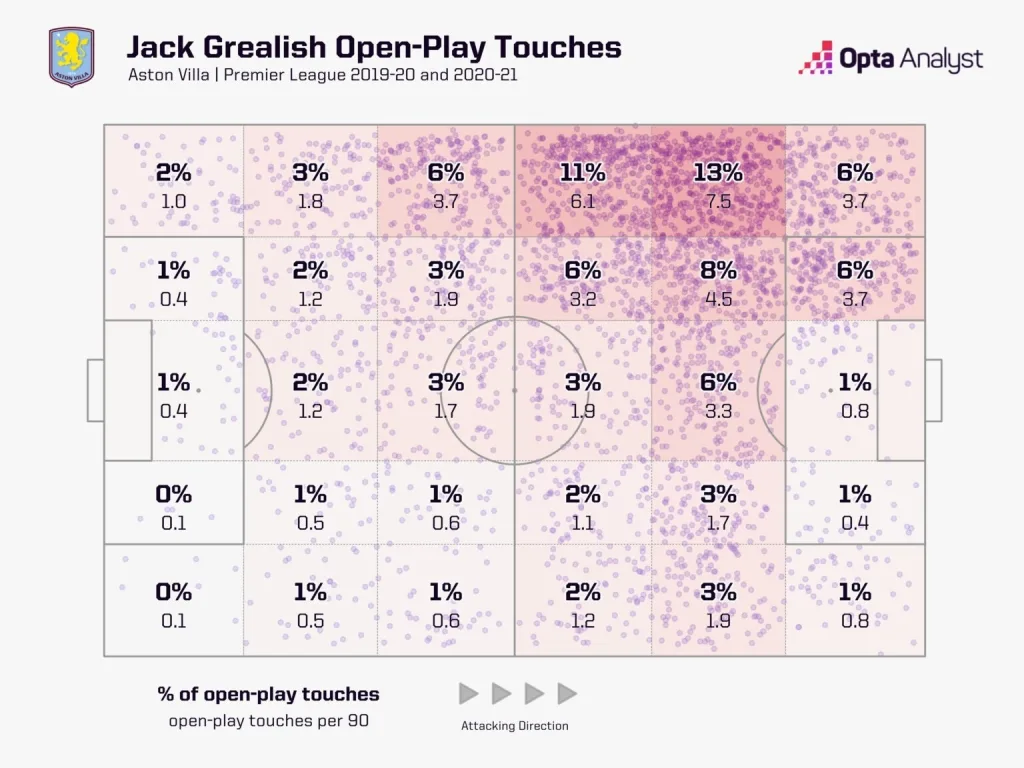
“I had more freedom at Aston Villa,” Grealish admitted when discussing his adaptation period at Manchester City. “I had a lot more of the ball at Villa, whereas here [at City] you probably don’t touch the ball as much because you have so many world-class players.”
Statistical Evidence of Greater Freedom
While the statistics reveal that Grealish didn’t actually touch the ball more frequently at Villa, he did have a higher proportion of his team’s total touches – indicating greater involvement in Villa’s attacking play.
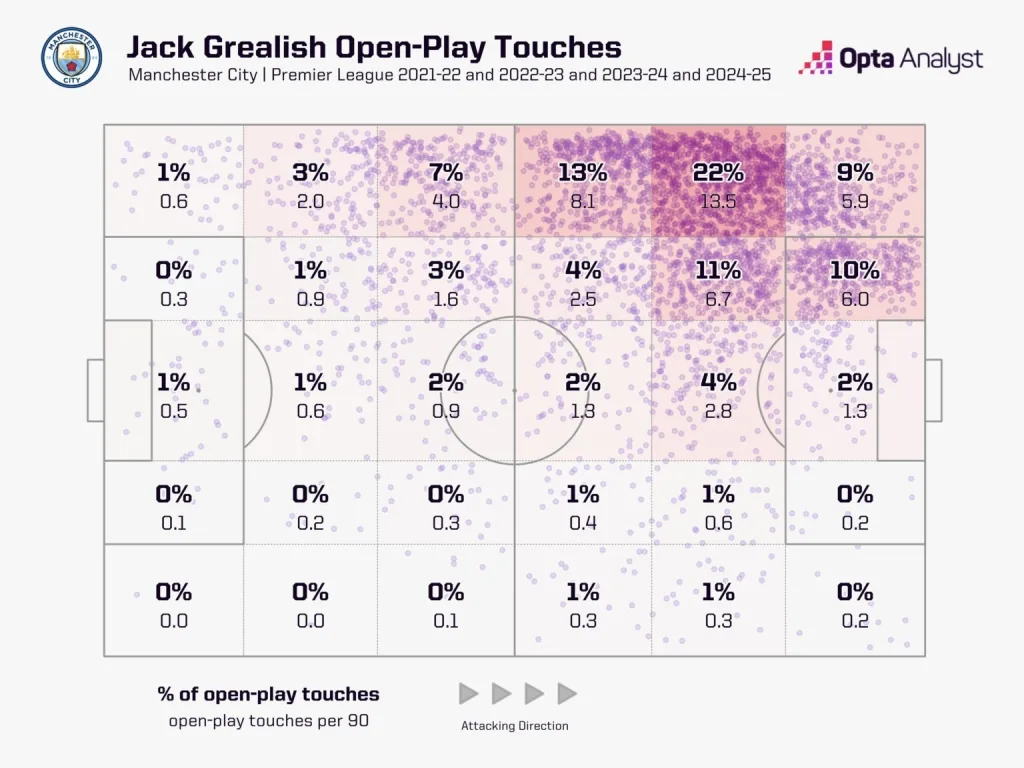
More significantly, he made considerably more dribbling attempts during his Villa years. In each of his final three Premier League seasons at Villa Park, he averaged between 3.8 and 5.5 dribble attempts per 90 minutes. This contrasts sharply with his Manchester City period, where he averaged between 2.6 and 3.5 dribble attempts per 90 minutes across four seasons.
| Club Period | Dribble Attempts per 90 | Percentage of Total Touches |
|---|---|---|
| Final 3 Villa seasons | 3.8 – 5.5 | 6.1% – 10.4% |
| 4 City seasons | 2.6 – 3.5 | 3.8% – 5.7% |
The difference in dribbling frequency represents more than just statistical variation – it reflects a fundamental change in how Jack Grealish was utilized tactically.
Positional Freedom: The Key to Unlocking Grealish
At Aston Villa, Jack Grealish was allowed to roam the pitch freely, essentially instructed to position himself wherever he felt he could best influence the game. He served as captain and was unquestionably their most important player, taking up more central positions than he would later at City.
Many of his Villa appearances came in central midfield or as a number 10, but even when deployed on the left flank, he was permitted to drift inside in search of space. When playing centrally, he would move out to the right or drop deeper to get on the ball – tactical flexibility that maximized his natural instincts.
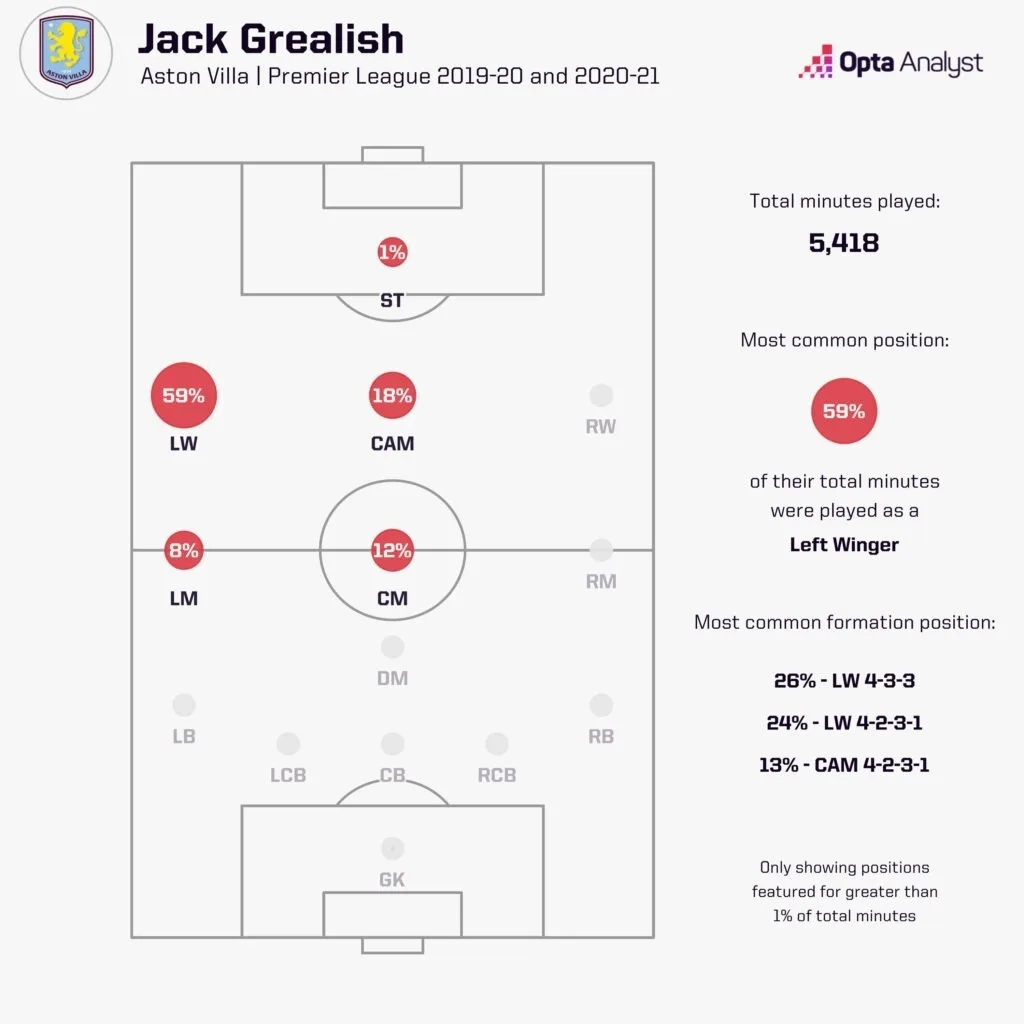
At Manchester City, the situation was markedly different. Jack Grealish played 87% of his Premier League minutes positioned on the left wing, with strict adherence to Pep Guardiola’s juego de posición (positional play) system. While this tactical discipline clearly worked – there’s no doubt Guardiola developed aspects of his game significantly – it also constrained the off-the-cuff dribbling and creativity that made him special.
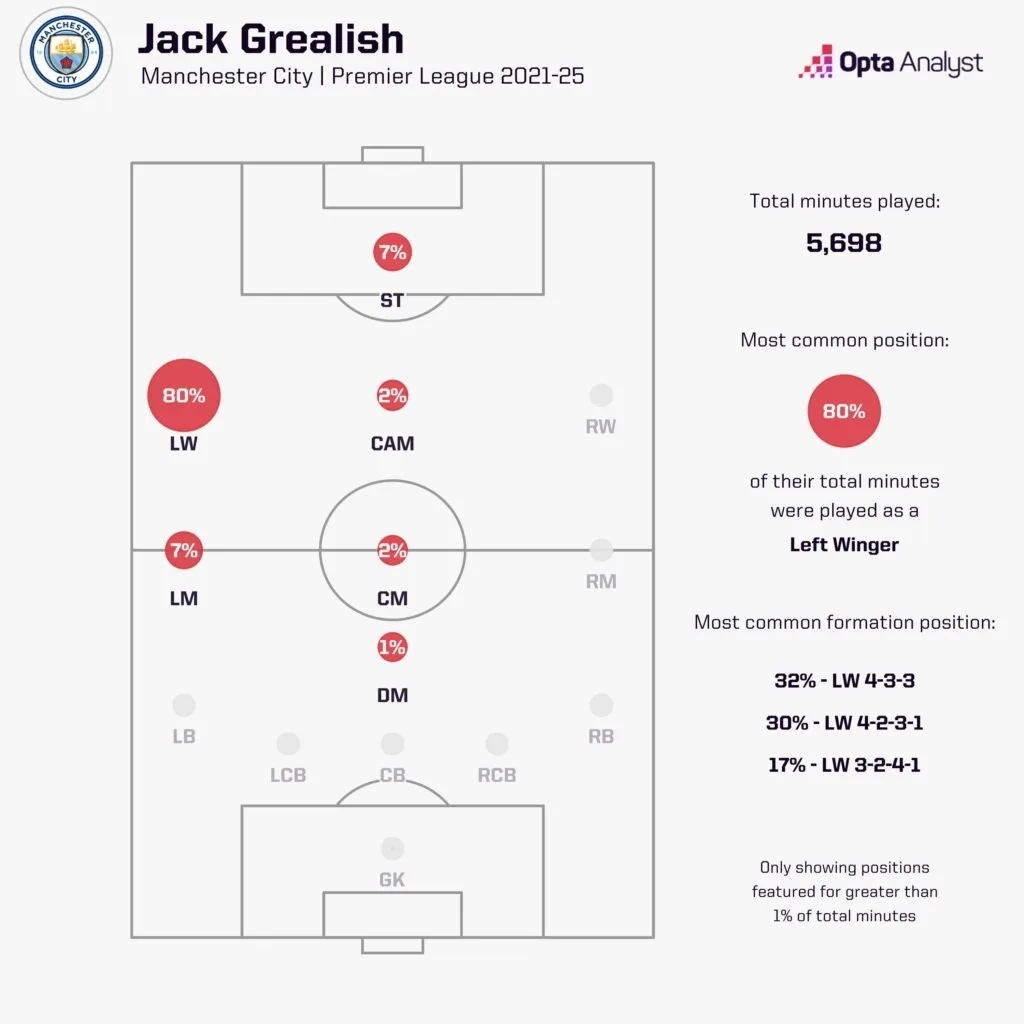
Grealish himself acknowledged Guardiola’s impact, calling the City manager a “genius” after their Champions League triumph together. However, there’s something to be said for allowing a naturally gifted dribbler and creator like Grealish to play with the freedom he enjoyed at Villa.
Everton’s Creative Crisis: The Perfect Opportunity
The timing of Jack Grealish’s arrival at Everton couldn’t be better from both perspectives. Chance creation was a significant problem for the Toffees last season, with only the three relegated teams generating a lower expected goals total in open play than Everton’s meager 28.8 xG – averaging just 0.76 expected goals per game.
This creativity deficit makes Grealish’s potential impact even more pronounced. Despite enduring his worst season in years at Manchester City, he still created almost twice as many chances in open play per 90 minutes (2.9) as any Everton player managed – with Charly Alcaraz leading their charts with just 1.5 chances created per 90.
| Team/Player | Expected Goals (Open Play) | Chances Created per 90 |
|---|---|---|
| Everton 2023-24 | 28.8 (0.76 per game) | 1.5 (best player) |
| Jack Grealish 2023-24 | N/A | 2.9 |
The fact that Grealish was playing for Manchester City rather than Everton certainly contributed to this disparity, but it still represents a stark difference in creative output even during what was arguably his worst season in years.
The Challenge Ahead: Consistency is Key
The primary challenge facing both Jack Grealish and Everton is achieving consistency. His recent form makes for concerning reading – just two assists in his last 29 hours of Premier League action represents a significant drop-off from his previous standards. For this loan move to be considered successful, Everton will need to see substantial improvement in these numbers.
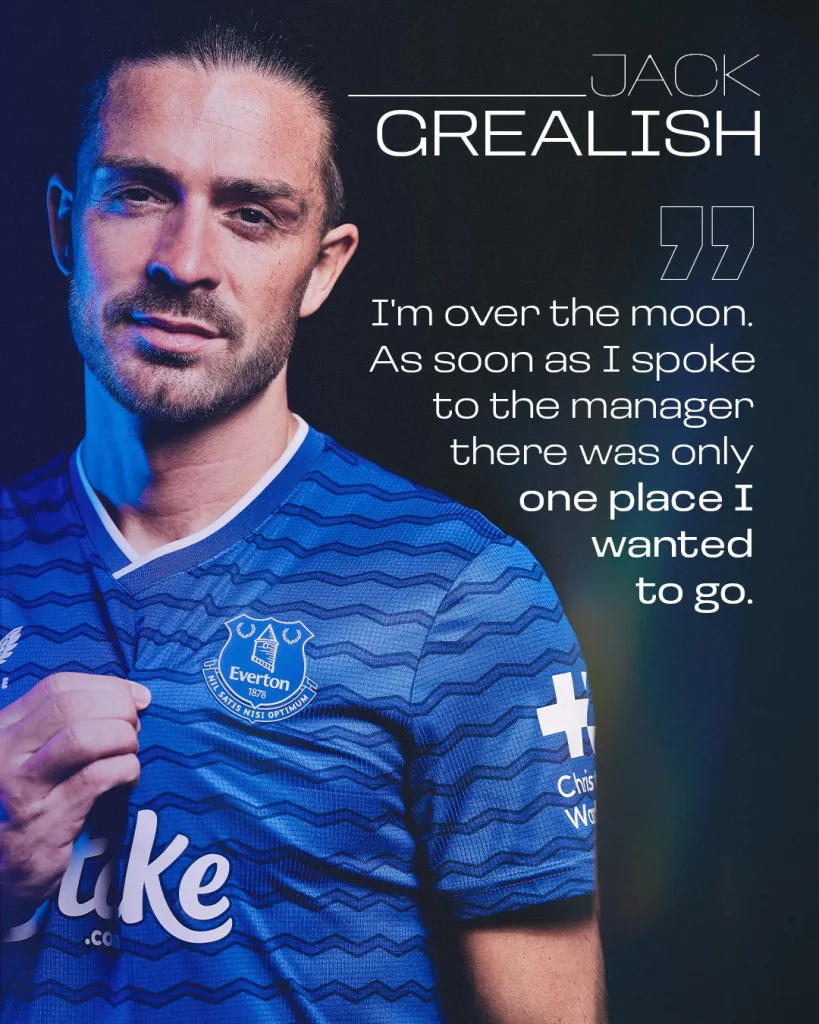
With Iliman Ndiaye likely to occupy central areas, Grealish will probably start from the left wing at Everton. However, few expect him to maintain his position as religiously as he was required to do at Manchester City. The tactical setup should allow him more freedom to drift inside and influence central areas of the pitch.
Tactical Adjustments: Adapting to a Different Style
The transition from Manchester City’s possession-heavy approach to Everton’s more direct style will require significant tactical adjustments from Jack Grealish. At City, the team typically dominated possession and created chances through patient build-up play. At Everton, he’ll need to be more clinical with limited opportunities and contribute more defensively when the team is out of possession.
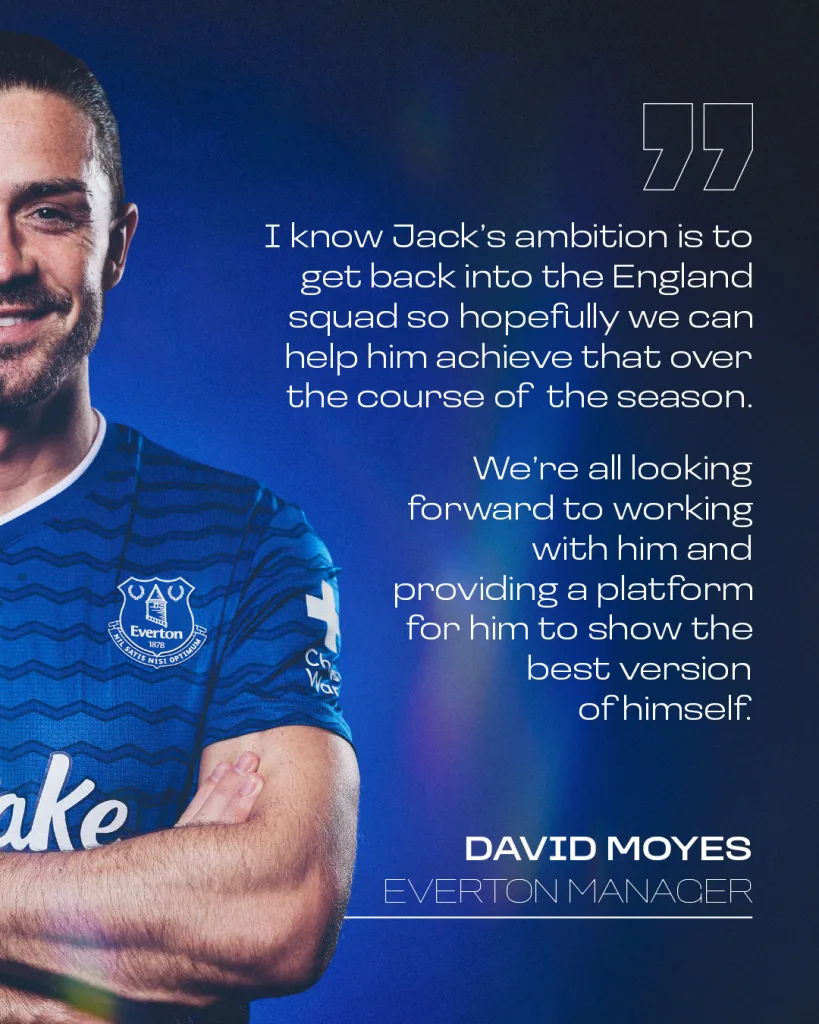
However, this change in approach might actually suit certain aspects of his game better. The counter-attacking opportunities and transitional moments that are more common in Everton’s style could provide the space and freedom that allowed him to flourish at Aston Villa.
The Psychological Factor: Proving a Point
Beyond the tactical considerations, this move represents a crucial psychological test for Jack Grealish. The pressure of living up to his £100 million transfer fee at Manchester City, combined with the constant scrutiny of playing alongside world-class teammates, may have affected his natural game.
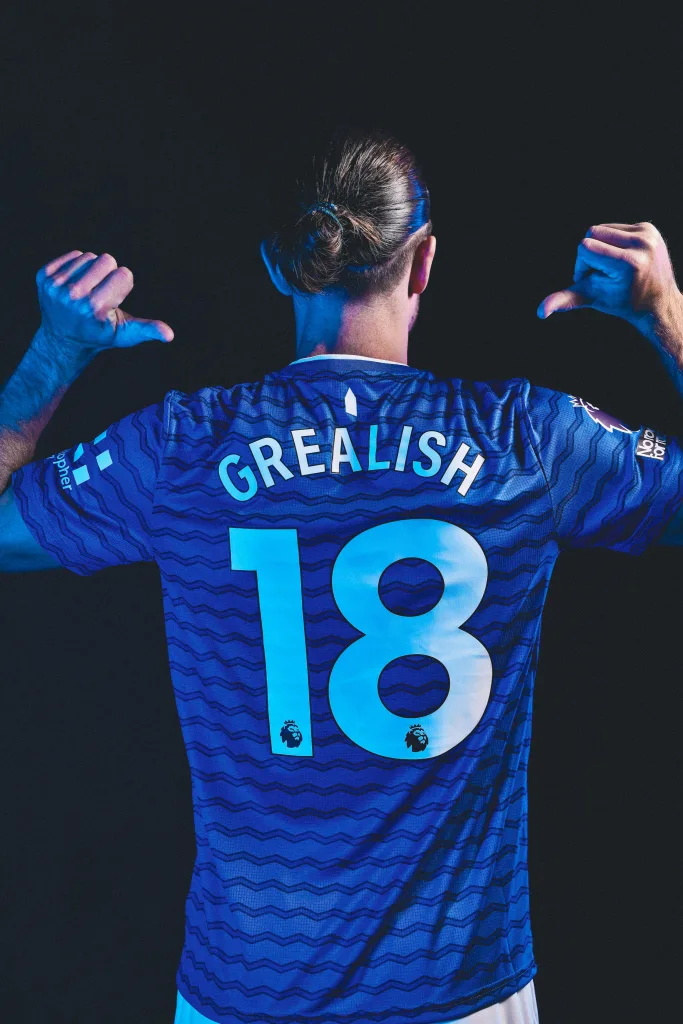
At Everton, he has the opportunity to be the standout performer rather than trying to fit into an already elite system. This shift in responsibility – from supplementary player to main creative force – mirrors his situation at Aston Villa where his individual brilliance often determined results.
The Verdict: A Make-or-Break Moment
As Jack Grealish approaches his 30th birthday, this loan spell at Everton represents more than just a change of scenery – it’s potentially his final opportunity to prove he belongs among the Premier League’s elite players. The combination of tactical freedom, reduced pressure, and the chance to be a key player again creates the perfect conditions for revival.
The football world will be watching to see whether this represents the beginning of a redemption story or the continuation of a disappointing decline. For a player who once terrorized Premier League defenses with his pace, skill, and creativity, the stakes couldn’t be higher.
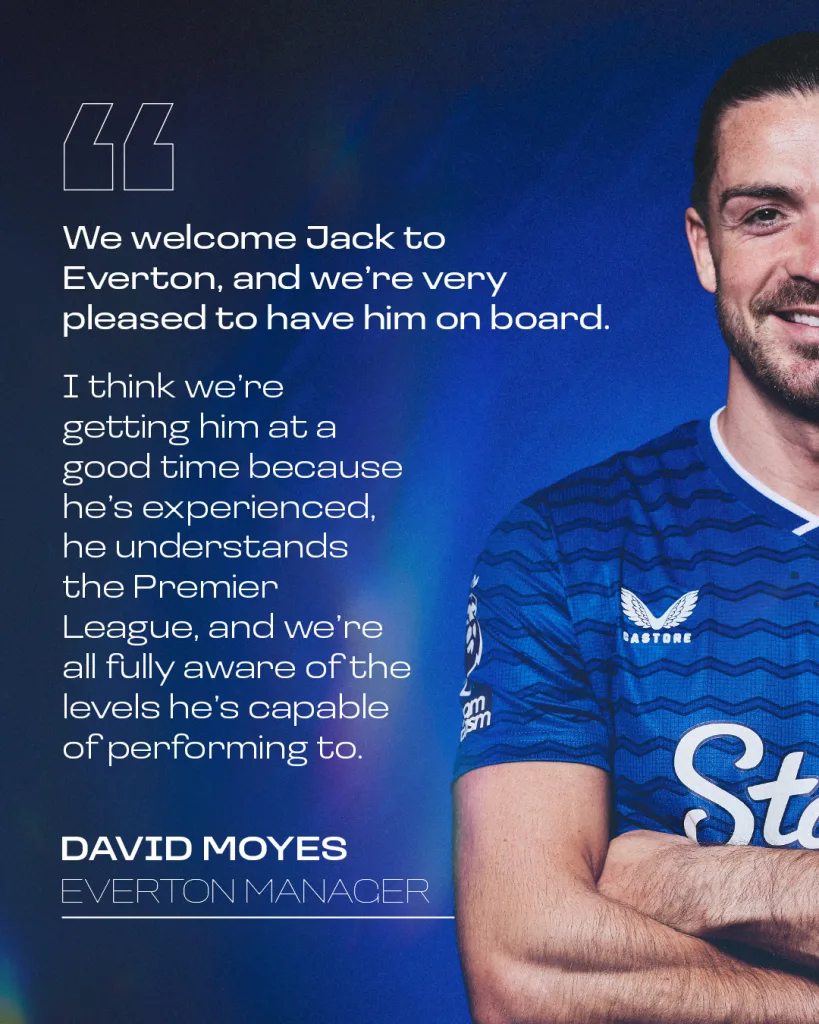
Success at Everton could reignite his international ambitions and prove that his struggles at City were more about tactical fit than declining ability. Failure, however, might signal the end of his time at the highest level of English football.
There are many people who would love to see Jack Grealish return to his happy, unstoppable best. If he can rediscover even a portion of his Aston Villa magic at Goodison Park, football fans everywhere will be in for a treat.
Read More: Manchester United Agree Season-Long Toby Collyer Loan to West Bromwich Albion
FAQs
Why did Jack Grealish move to Everton on loan?
Jack Grealish moved to Everton because his Manchester City career had stagnated badly. Despite being part of their treble-winning team in 2022-23, he played just 30% of available minutes in 2024-25 and needed a fresh start to revive his career before turning 30.
How did Jack Grealish perform at Manchester City?
While Jack Grealish was crucial to City’s 2022-23 treble success, playing 90 minutes in both the Champions League and FA Cup finals, his form declined significantly afterward. He managed only 1,004 Premier League minutes in 2023-24 and even fewer in 2024-25, scoring just one goal in over a year.
What was different about Jack Grealish’s role at Aston Villa?
At Aston Villa, Jack Grealish had much more tactical freedom, averaging 3.8-5.5 dribble attempts per 90 minutes compared to 2.6-3.5 at City. He could roam the pitch freely, often playing centrally or drifting inside from wide positions, rather than being restricted to the left wing.
What are Everton’s expectations for Jack Grealish?
Everton desperately need creativity after generating only 28.8 expected goals in open play last season (just 0.76 per game). They’ll expect Grealish to significantly improve their chance creation, as he averaged 2.9 chances created per 90 compared to their best player’s 1.5.
Can this move save Jack Grealish’s career?
This represents potentially Jack Grealish’s final chance to prove himself at the highest level, given he’s approaching 30. The tactical freedom and reduced pressure at Everton mirror his successful period at Villa, but he must improve drastically from his recent form of just two assists in 29 hours of Premier League action.

